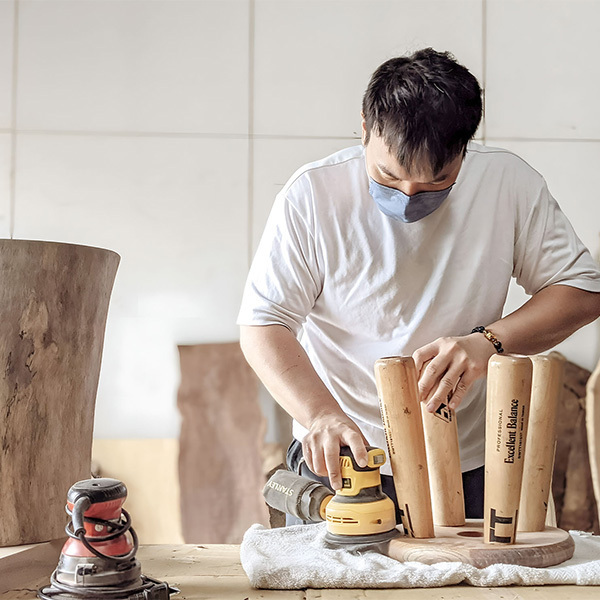Sea vegetable Circulation
合同会社シーベジタブル SEA VEGETABLE COMPANY
HONOKA
古くから日本で愛されてきた畳は、香り豊かで肌触り良く調湿や消臭の性能を備えた植物から作られている。しかし生活様式の変化により、近年畳に触れる機会は減少した。「TATAMI ReFAB PROJECT」は大型3Dプリント技術を用いて、畳を現代の暮らしに編み直すプロジェクトである。使い終えた畳や廃棄される原料を再生可能樹脂と混ぜ合わせ、新たな魅力の家具を制作した。我々はこのプロジェクトを通じて畳の魅力を次世代へ発信しく。
畳屋の前に大量の畳が捨てられているのを見つけたのがきっかけとなり、詳しく調べていくと畳の需要が減っている、畳の再利用方法が見つかっていないという現状を知り、長く日本で親しまれてきたものが失われないよう何かできないかと考えた。畳は香り豊かな上に消臭・調湿効果等さまざまな機能があるが、板状や水に弱いという制約もある。それを補うために樹脂に混ぜることで成形性、防水性を付加できると予想し素材作りから始めた。ベースの樹脂も酢酸セルロースという生分解性樹脂で環境負荷の低いものを選定している。その結果うまれたのが、い草を樹脂に混ぜた素材で家具を創るプロジェクトである。
プログラムディレクター(Helsinki Design Week & Weekly、Fiskars Village Art & Design Biennale、Luovi Productions Ltd)
Love the realization and the dialogue between the old and the new! I could imagine TATAMI ReFAB PROJECT creating a meaningful bond for the product and the end user through the use of traditional references. The sense of familiarity might create engagement too. I’m happy to see the project fighting the global phenomena of the loss of dexterity and the decreasing use of traditional (local) craftsmanship through making use of these valuable skills and creativity in new contexts.
このプロジェクトの仕上がりと、伝統と革新の間を行き来するアプローチが気に入っています。TATAMI ReFAB PROJECTは、伝統を参照することで製品とエンドユーザーとの意味のある絆を生み出し、その親しみやすさもエンゲージメントを創出します。 手先の器用さと伝統的な(地域の)職人技が失われつつあるという世界的な現象に、貴重な技術や創造性を新しい文脈に活かして対抗するこのプロジェクトをうれしく思います。
Singularity University 学部議長、Community and Impact部門 元部長
The project transforms a material again and again. First a plant is turned into a tatami mat. Then a tatami mat is turned into beautiful furniture and objects with the help of 3D printing. 3D printing will also allow anyone to design and create their own objects. The project is recycling goods as well as helping people see what a tatami mat can become, at a time when they are being replaced by less sustainable goods. The project leaders mentioned they hoped to connect the project to the original farmers. It might be possible to use a sensor and block chain technology to track the original materials over the course of their lifecycle. The farmers could see the different products other people create with the tatami over time and farmers could receive a financial compensation every time the tatami is turned into something new and (re)sold. Perhaps everyone who participated in the tatami's journey could be kept up to date and compensated. Over time an object's value increases the more times it is recycled through its life, creating an economy that incentives recycling.
このプロジェクトでは、素材が何度も変化を遂げます。まず植物が畳になり、畳が3Dプリンターによって美しい家具やオブジェに生まれ変わります。さらに、3Dプリント技術によって誰でも自分だけのオブジェクトをデザインして作れるのです。これは商品のリサイクルであると同時に、持続可能性の低いマットに代替されつつある畳がどんな形でもとり得ることを私たちに教えてくれるものなのです。プロジェクトリーダーによれば、このプロジェクトを元の農家につなぐ構想があるとのこと。それが実現すれば、 センサーとブロックチェーン技術で原材料までライフサイクルを追跡できるかもしれません。 農家は、その畳を使って他の人々が作るさまざまな製品を時間の経過とともに見ることができ、畳が新しいものに生まれ変わり(再)販売されるたびに収入を得られるようになるのです。さらに、畳のジャーニーに関わったすべての人が最新情報を共有し、対価を得ることさえ可能かもしれません。 時を経るほど、リサイクルされるほどモノの価値が高まるようなライフサイクルが確立されれば、そこにリサイクルを奨励する経済が生まれるでしょう。
東日本旅客鉄道株式会社
イノベーション戦略本部 デジタルビジネスユニット マネージャー
モビリティ変革コンソーシアム 事務局長
畳は日本人としていつまでも残していきたい昔ながらの家具であるが、需要の減少や職人の不足から将来消滅してしまうおそれがある。現在、新規に畳の需要を増やすことは難しく、なかなか妙案がない状態が続いたなかで、この取り組みは今の時代に合わせた形に畳をリノベーションさせ、そこに職人の活躍する場所も与えることから、文化的にも環境的にもとても意義があるものと思う。「畳」に新たな可能性を与え、様々な形態に生まれ変わらせる可能性を秘めており、今後が非常に期待されるものである。
MATR
MATR
Dodola
Pjorkkala
re:Mix, the circular kitchen mixer for your own glass jars
Open Funk
CirculaRElectronics by VERTMONDE
VERTMONDE ECUADOR
MateRe-DPP
株式会社digglue / digglue. inc
Transparent Solar Windows
VP for Ubiquitous Energy
プロジェクト「TSUMUGI」
一般社団法人アップサイクル General Incorporated Association Upcycle
The Mother Reef
Oyster Heaven
Anam PALF® by Ananas Anam
Ananas Anam
DiFOLD Origami Bottle
DiFOLD
Co-producing value-added, biodegradable plastics and additives from agricultural byproducts
Ourobio
Infinity Toy Box
Infinity Toy Box
Lichens as an bioindicators of "Well-being"
Yixuan Wang (collaborated with Julio Obscura)
Tejiendo la calle
Tejiendo la calle
comvey シェアバッグ®︎
株式会社comvey 代表取締役 / Comvey. Inc. CEO
“捨てないくらし”をかなえる。「くらしのサス活 Circular Action」
株式会社ECOMMIT ブランド戦略部 広報ブランディンググループ 所属
Hair Recycle
Dung Dung asbl
Lalaloop Reusable cup system for a circular city
OysterAble co., ltd.

Bio-invasive Textile Library
Bio-invasive Lab Ltd/ Central Saint Martin-Ma Biodesign
MateRe
株式会社digglue / digglue inc.
Briiv Air Filter
Five Create Ltd.
Gravity Wave - Plastic Free Oceans
GRAVITY WAVE
Seaweed Dialogues
Alberte Holmø Bojesen
記憶のえんぴつ
obake
